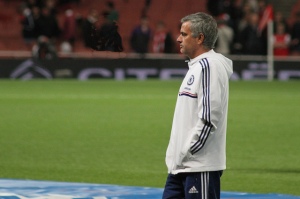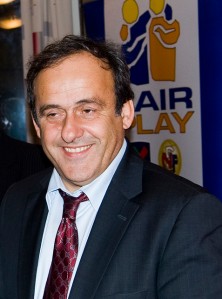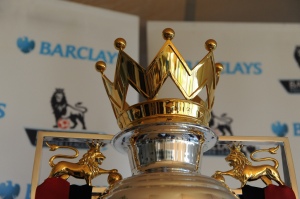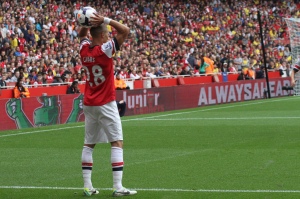Category Archives: Uncategorized
Is Football changing?
This past week has seen many people question the tactics of football managers and playera alike. Conservative play saw Cheslea run out 2-0 winners at Anfield on Sunday, something which seemed to spark fans into criticising Chelsea and manager Jose Mourinho. Bayern Munich manager Pep Guardiola, famed for his love of passing football saw his side lose heavily to Real Madrid who played largely on the counter. The time of Guardiola’s Barcelona has passed obscenely quickly, so is football changing?
This is of course a largely opinion based question. Most fans would want their side to play beautiful football, something Chelsea owner Roman Abramovich is known to desire, but Mourinho has a ‘win at all costs’ mentality. The Blues’ fans many love Mourinho, but the last thing the owner wants is to be criticised for ugly football. He must learn though, with Mourinho, he will play rough if it is more likely to get the right result. The Portuguese wasn’t like this in his first spell in charge though, was he?
Mourinho’s CV has grown, as has his experience. In other leagues, the fast paced tempo isn’t the same as the Premier League, so when a trip to 96 goal Liverpool came up, he didn’t want the game to be open. Boring it may be, and different to his younger self, but it is not football that is changing, it is the managers.
Guardiola may be succumbed to this also after a humbling 4-0 home defeat to Real Madrid. If he could go back and win 2-0 by packing the defence and playing on the counter, do you think he would? Or would he be too proud to do so and take the heavy loss by playing the way he wants? One final question, does he now change what he wants in order to get results? Leave a comment with your view.
Either way, it is a delicate topic, but I think football isn’t changing, the managers are with experience. There are a new breed of manager who are addicted to passing football and that is a good thing for the neutrals. They will have to learn that winning ugly will have to happen sometimes, but maybe for Mourinho, the club he’s at doesn’t suit it.
What is Financial Fair Play?
A lot has been written this week about Financial Fair Play (FFP), and a lot has been sent in to various news outlets and media companies saying ‘I don’t understand it’. Well, this article explains it very well and you could read that, which I have provided. I am of course hoping that if you are continuing to read these explanatory stories that you will stick with mine. It’ll have a little from that page too, of course.
Manchester City and Paris Saint Germain have fallen foul of the FFP line, but did you know for example that clubs in the Football League are subject to these rules too? You did? Oh, okay. Although they cannot feel as much of a punishment as the big European clubs, a maximum 60% can be spent of their turnover can be spent on wages. Clubs in Leagues 1 and 2 have to be monitored every month. Clubs in the Championship can also only record a loss of £8m a season, or £3m if their owners cannot input the remaining equity. If they are deemed to have overspent in order to get into the Premier League, then they can be subjected to a fine and a transfer ban.
On to the big guns however, and the rules apply as of this season to the Premier League and UEFA competitions. Over three seasons, they can only record a maximum loss of £105m if the owners of the club can put in the equity, or £15m if they cannot. If they fail to do this, they can be given a points deduction. There are no restrictions for wages if they are below £52m a year. You’d be forgiven for thinking that sounds like a lot. Wayne Rooney’s £300,000 a week deal will earn him £15.6m a year however. Exactly.
For UEFA it get’s a little more complex. Really, that’s only because the sums are mainly in Euro’s. The permitted losses are a measly €45m when compared to the Premier League. This is only €5m over three years if the owner cannot afford to pay out. This has a hand in making you realise just how big England’s elite are in world football.
All of these sanctions have exclusions, for example if some of these funds are to help in a club’s community scheme. This is also affected for youth development costs. Clubs can appeal for other reasons also, such as career ending injury costs, so the rules are not quite as rigid as you may think.
I hope this article has helped your basic understanding of the rules and regulations. You can engage in the conversations about the economics of football in the pub if you so desire.
Related articles:
UEFA Financial Fair Play website
BBC article about wages and money in football
The Premier League race
We’ve seen it many times before, when the race comes down to the last day and even the last minute. The famous Aguero goal against QPR will forever live in the memories of Manchester City fans when they secured their first title in 44 years in 2012. Last season may have been a little less memorable.
Their city rivals were awaiting their result that season though with a strong chance of winning the Premier League title. So where does the trophy go, or if there are more than one, who decides where the original travels?
If you are a fan of a team that has been in the title race over the last decade or so, then you are probably more aware than most.
There is a replica of the trophy for when the race is not over on the final day, although where the original trophy goes, it is not clear. If the race is over, obviously the trophy arrives at the stadium of the Champions, with a guard of honour waiting.
The table is determined by points, followed by goal difference, and then in the event of a tie in both of those categories, goals scored. The 2011/12 season was the first to be determined by goal difference, and the league has never been decided on goals scored. With Liverpool top scoring so far this term at the top of the table and Manchester City not far behind, this could be a record breaking year in more than one sense.
Next Thursday’s poll will be who you think will win the Premier League title to give you a little more of an idea following Sunday’s crunch match at Anfield.
Related articles:
The Guardian on the tactical battle at hand on Sunday
Sport England have cut funding, but who are they?
It was announced recently that Sport England would cut the FA’s funding by £1.6m due to a lack of improvement of football at grass root level. Hockey and Netball also felt the pinch whilst arguably the biggest sport to remain unscathed was Cricket, despite a drop in numbers also. If this group of people have the ability to dictate funding, then why don’t we know more about them?
Firstly, the key members are appointed, and not elected by the public, so they have little to no accountability in their roles. Their board is made up of 11 members, 3 of whom are recognized by the Queen. Previously known as the English Sports Council, Nick Bitel is the Chair having been a board member for three years. He was appointed to the role in April 2013, and has held the position of London Marathon Chief Executive. Not only this, but he is a solicitor and consultant in sports law as well as being on the board of UK Sport. You can find more information on the board here.
Their executive team is made up of seven people, with Phil Smith the Director of Sport. Smith has been the FA’s Head of Public Affairs. Jennie Price is the Chief Executive of the team and has been with Sport England for seven years after a career in politics.
It’s safe to say that these members are more than qualified to do their job, but why are they not more accountable for the vast role they play in the funding of sports in this country? Well, Ministers appoint the members. For example, it was Hugh Robertson MP, Minister for Sport and the Olympics that appointed the current Chairman and five other members the last time the board was altered.
So the Government appoints the members with their sole aim to get more people playing and enjoying sport. As we have seen recently, if participation doesn’t improve then funding will get cut in this difficult economic period. Whatever your view on whether that’s fair or not, the role these members play is undoubtedly a very large one in sport and development in this country.
Related links:
No Arsenal player to be suspended
I assume everybody enjoyed the football this weekend. I certainly did. If you didn’t, either your team lost or you just aren’t a fan, which is absolutely fine of course!
Stamford Bridge has to be the place to start though as the weekend’s proceedings began and within 15 minutes the game was likely to be overshadowed by the referee than any of the magnificent performers in blue on the sunny afternoon. As I’m sure you’re aware, Kieran Gibbs was shown a red card for nothing, with Alex Oxlade-Chamberlain walking free having handled the ball in the box, and quite impressively at that. What you may not be aware of yet though, is that Arsenal have had two appeals successfully upheld meaning that no player will be suspended in the following games of the season.
How though, is this decided?
Well, firstly, Arsenal are given a deadline to appeal the red card decisions. The first step to take would be to appeal for mistaken identity, basically stating the obvious that it was not Gibbs that should seen red. An independent three man panel then assesses the written response from Arsenal, followed by footage of the incident. Secondly after this comes the real debate of whether it should be a sending off offence.
The rule states that it is a red card if the player ‘prevents a goal or an obvious goal scoring opportunity by deliberately handling the ball.’ It then goes on to state that this is ‘not from the act of the player deliberately handling the ball, but the unfair intervention that prevented the goal being scored.’ Therefore, the panel must assess if it prevented a goal rather than if it was handball. The footage would show quite obviously, that it was a handball but that the ball was travelling inches wide, thus not preventing a goal. Trivial you may think, but mightily important.
You can find the rules and regulations from the FA and yellow and red card offences here.
So there you have it. Following Andre Marriner’s error of judgement, no Gooner will be suspended for their game against Swansea on Tuesday following the game at Stamford Bridge. Plus, you now have a little bit more knowledge around how this is decided. If you have any views on the matter, feel free to comment below.
Related links:
Cheltenham Festival; we’ve seen the winners and losers, but what does the event take to appear on the World Stage?
The Gold Cup, Hats, Ruby Walsh, all synonymous with the Cheltenham Festival. Indeed, it is one of, if not the main event of the horse racing calendar. The winners are heard worldwide and take home more than just pride. So just what are the numbers that surround the four day racing feast?
In 2012, over 200,000 spectators supposedly waltzed through the gates, taking in around a staggering figure of £7m. That is pocket change when put in comparison to how much money was staked on the races two years ago. £600m was placed upon various horses’ shoulders as they galloped down the track.
Every year, around 5,000 extra staff are needed to cope with the punters and celebrities alike. When you consider that the festival hosts the largest tented village from any sporting event in the world, you can understand why. Around 20,000 bottles of the finest Champagne are consumed, just to add that little bit of extra merry to your day. Around 250,000 pints of Guinness is also poured.
The prize money peaks at around £3.7m for the festival, but hits £6m throughout the whole season. As you ponder those facts, why not enjoy one of the all time greats winning the Gold Cup 25 years ago.
Related links:
The official website for the course
How does an ice bath work?
Ice baths, we hear about them all the time and probably cringe at the thought of them, even if you’ve been unlucky enough to experience one. I, fortunately, have not.
Why do athletes, professional sportsmen and women need to endure the bitter torture? Why not simply have a massage and relax after an event? Well, the ice plays a vital role in recovery, both in the short term and the long.
The body repairs itself with the aid of blood vessels that get rid of waste that builds up during exercise, and brings oxygen to the tissue. The ice numbs the legs and individual muscles, meaning that upon exiting the bath, fresh blood enters the muscles with new oxygen, helping the cells to work more efficiently.
The build up of lactic acid is one of the most frequent problems for an athlete and can lead to long term fatigue, so ridding of this is one of the most important roles the ice plays for their career.
All of these benefits mean the ice bath is irreplaceable and huge in sporting professionals avoiding injuries and stay fresh. Even though it seems the bath can do no wrong, I will be staying well clear.
Related links:
Advice about the use of ice baths
A male point of view on the health benefits using of freezing water.
Curitiba; just what goes in to building a World Cup stadium?
A lot has been made of Brazil’s efforts and struggles in building their stadiums ahead of the FIFA World Cup this summer. We have seen many tragedies of construction workers being killed in the ruthless work that has to take place to meet the deadlines.
To quote FIFA and President Sepp Blatter from their guide ‘Football Stadiums- technical recommendations and requirements’, “Ever since the dark days of the 1980’s, FIFA has taken up the question of safety in stadiums time and time again in its quest to continuously improve the standards of modern arenas.”
So, what does it take to build a World Cup football stadium?
At 18:00 on Tuesday, Curitiba was given the green light as to continue being a venue for the World Cup in the summer. Currently, 1,500 workers are expected to be on site between now and May, giving an idea of just how much man power is required when a project this big falls behind. In the case of Curitiba, it is a renovation project rather than a brand new building, therefore it has to be upgraded to FIFA standards to meet the other 11 host cities in holding the tournament in the summer.
The original stadium opened in 1914 and now holds over 40,000 people. As well as adding seats and cleaning the stadium, a media area is also needed, especially for an event this large. Who should pay for this installment is already proving to be a sensitive subject in Brazil, as Atletico Paranaense own the stadium.
In FIFA’s guide, they state that, upon redevelopment “a stadium should be situated in a location which is sufficiently large to provide spacious and safe external public activity.” Being located just south of Sao Paolo, the stadium’s placement is neither perfect nor a disaster for its three games beginning on the 16th June with France facing Nigeria.
These are some of the standards and considerations that go into building a World Cup stadium, but truly we won’t be able to tell whether construction workers have suffered the hard work in vain or for a great success in the country considered to be the heart of football until the World Cup is underway. Even with just under four months to go until the opening matches of the tournament, Brazil is still pumping as hard as ever to be ready for the greatest football event in the world.
Related articles:






